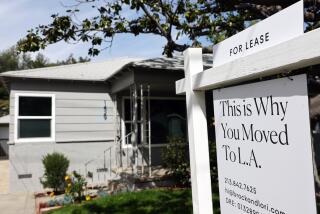No Time to Stretch Housing Definitions
- Share via
Seven-year-old Antonio Rodriguez and his 5-year-old brother, Jairo, got their first bath last week in a real tub. They played for almost an hour in the warm water--a real change from the cold, makeshift showers they were used to.
Their mother, Paloma, cooked dinner on a gas range and got her first look at a dishwasher. No more campfire cooking or hauling water for cleanup.
That night the boys and their parents slept on the carpet of their new two-bedroom apartment because they didn’t have furniture. But it was a far cry from sleeping on the ground in illegal encampments, waiting for an eviction notice from the county Department of Health Services.
The apartments that the Rodriguezes and two other families moved into last week are among the approximately 600 low-income housing units administered by the city of Carlsbad. Paloma Rodriguez and her husband, Lorenzo Santos, will pay 30% of their income for rent, and the rest will be paid through a federal housing program.
This family’s good fortune is heartwarming, but the joy is dimmed by the knowledge that thousands of other people in San Diego County are still waiting for decent, safe housing--people like Alicia and Moises Sahagun and their five children, who pay more than half their income for a mouse-infested, substandard home.
The Sahaguns are among the plaintiffs in a class-action suit filed by the Legal Aid Society of San Diego, which accuses the city of Carlsbad of improperly using low-income housing funds to build a senior citizen center and offices for the school district.
It’s hard to take issue with such a laudatory project as a senior citizen center. But the worthiness of the center is not at issue. And whether the city of Carlsbad is following the letter of the law, while important, is not the central issue, either.
What’s being tested is the sincerity of the commitment to the spirit of the law and to low-income housing by Carlsbad and other cities.
The state law in question requires that 20% of the additional property taxes generated by redevelopment projects be used to increase or improve low- and moderate-income housing, with the emphasis on low-income housing.
But many cities are accused of looking for every loophole or trying to stretch the definitions to avoid having to use the funds for low-income housing. Through the efforts of public-interest law organizations, many of those loopholes have been closed. Several lawsuits, such as the one filed by the Legal Aid Society against Carlsbad, are designed to keep the focus on increasing the supply of safe, low-income housing.
Carlsbad argues that the senior citizen center is designed to do just that. It says the center will encourage private developers to build low-cost senior citizen housing, even though there is no specific project waiting in the wings. Only a court can decide which side is right.
But when the city estimates that it would take almost 3,400 low-income housing units to meet the need projected for 1991, and when only about 50 units were added from 1986 through 1988, when the health department is pushing homeless migrants from pillar to post, that is not the time to be stretching definitions. Rather, it is a time when every available housing dollar should be put toward meeting the basic human needs of families like the Rodriguezes and the Sahaguns.
More to Read
Sign up for Essential California
The most important California stories and recommendations in your inbox every morning.
You may occasionally receive promotional content from the Los Angeles Times.






